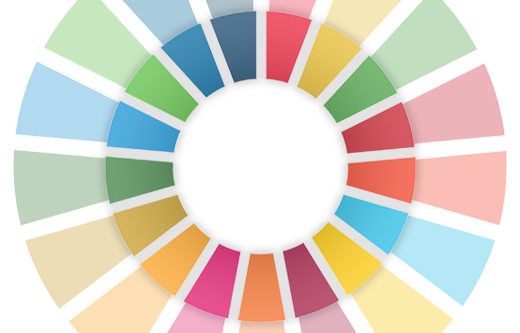Circular Ports
Circular Ports
Topics
Circular Port Monitor
Explore this topic
Delta Atelier
Explore this topic
What's the relevance of Circular Economy to the Sustainable Development Goals (SDGs)?
The Sustainable Develoment Goals (SDGs) articulate the global agenda for sustainable development
The Sustainable Development Goals (SDGs) or Global Goals are a collection of 17 interlinked goals and associated 169 targets, designed to be a 'shared blueprint for peace and prosperity for people and the planet, now and into the future'. The SDGs were set up by the United Nations General Assembly (UN-GA) as the Post-2015 Development Agenda as the future global development framework to succeed the Millennium Development Goals. They are included in a UN-GA Resolution, called the Agenda 2030, which sets targets to be achieved by 2030 in economic, social, and environmental sustainability. The SDGs are usually presented this way:
Away from addressing challenges and goals separately
The SDGs are meant to be communicated, understood, tackled, and tracked by governments, organizations, and individuals. They are also meant to be seen as a system of interconnected challenges, rather than different problems to be tackled individually. Thus, the Stockholm Resilience Center pushed for a new way of viewing the economic, social and ecological aspects of the SDGs, moving away from the current sectorial approach where social, economic, and ecological development are seen as separate parts. SDGs were re-structured in a systemic hierarchy, now referred to as the wedding cake, where economic growth, poverty, gender, equity are seen as interconnected dimensions of the same ecosystem within the space of a stable and resilient planet.
The wedding cake shows that economies are embedded in societies, and societies are embedded in the biosphere, and the biosphere has finite resources. It shows that society needs equity, as well as economy needs efficiency and effectiveness, otherwise there is no sustainability (Marcello Del Bono).
.png)
SDGs Wedding Cake Model (Source: Azote for Stockholm Resilience Centre, Stockholm University CC BY-ND 3.0.)
.png)
Explaining the new way of viewing the SDGs systemic hierarchy (14 minutes video)
Prof. Johan Rockström & Pavan Sukhdev (EAT Stockholm Food Forum, June 2016)
(critics) All this immediately invites comparison with Kate Raworth's Doughnut, but another comparison, perhaps, is with the Daly and Meadows modelling of the Earth system and human society.
A systemic view such as the one provided by the wedding cake and other models could help us better understand and communicate the urgency of the challenges, the intricacies of the interconnected relations between goals, and the potential for (in)direct actions that countries, organizations, and individuals could put in place.
The relevance of circular economy to the SDGs
CE is one of the main building blocks of the European Green Deal to realize sustainability goals as climate neutrality. By using CE as a means to ahieve climate goals, CE practices and related business models can (potentialy) contribute directly to achieving a sizeable number of the SDG targets. In particular for SDGs related to energy, production, consumption and waste (SDGs 6, 7, 8, and 12). In addition, there are also interfaces with other SDG goals, such as 'Good health and wel-being' (SDG 3) and 'Life on land' (SDG 15).
Because different policies focus on both the SDGs an the circular economy, information about how these different perspectives can influence each other positively or negatively is becoming increasingly important.
As much as the CE can help in achieving many SDG targets, the SDGs also can help the promotion of CE practices. Progress on many of the other SDG targets, which are not directly related to CE, will benefit the uptake of CE practices. Of particular importance are SDG 16 (Peace, Justice and Strong Institutions), SDG 4 (Quality education) representing the 'software' elements of governance and skills, and SDG 9 (Industry, Innovation and Infrastructure) representing the 'hardware' elements of facilities and infrastructures for a circular economic system (P. Schroeder, 2018).
Related explainers
.png)

Latest Update 09-12-2022
.png)
.png)